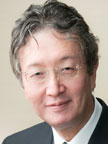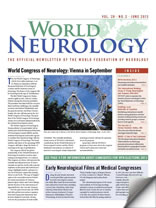After serving as an elected trustee for six years and as the chair of the Asia Initiative for three years, I would like to introduce myself as a candidate for the first vice president.
Background
When WFN was launched in 1957, its aims were “to disseminate information in neuroscience, to foster international collaboration in research and to help neurologists in developing nations provide neurological services.” The Japanese Society of Neurology was founded in 1960, being encouraged by WFN. Per request from WFN, the Japanese Society hosted the first Asian Oceanian Congress of Neurology (AOCN) in 1962 in Tokyo.
As a young medical intern in Kyoto in 1981, I attended the World Congress of Neurology held there. The exposure to the distinguished neurologists strongly pushed me to become a neurologist. I chose my field as EMG and clinical neurophysiology, and after being trained in the U.S., I returned to Kyoto University with Professor Jun Kimura, who became the new chair of Neurology after his carrier in Iowa. I am glad he initiated me into WFN as I like this line of work very much indeed. We for the first time discovered IVIg as effective in treating multifocal motor neuropathy, a mimic of ALS. I also became interested in treating dystonia with botulinum toxin using EMG skills, entering into the field of movement disorders.
When I took the chair in Tokushima University in 2000, I organized a team accepting fellows from Asian countries. Among these, a Filipino neurologist drew our attention to lubag disease, an endemic dystonia-parkinsonism in her hometown. Collaborating with Filipino neurologists, we could clarify the causative gene, the pathology and treatments. We could not make it without dedication of the local experts, and were fortunate to return the achievements back to patients. The lesson we learned was that the collaboration has to be bilateral rather than unilateral. Working with our colleagues in neurogenetics, we discovered new genes causing ALS such as OPTN and TFG.
International Activities
During 2000-2006, I served as an executive member of the International Federation of Clinical Neurophysiology (IFCN). I planned and led an expert meeting for setting new electrophysiological criteria for ALS, which became well known as IFCN Awaji criteria. As a member of International Executive Committee of the Movement Disorder Society since 2009, I engaged in various educational activities on movement disorders.
WFN Activities
Under the presidency of Professor Aarli, I worked as the chair of the membership committee, welcoming Albania, Algeria and Kazafstan as new members. In 2010, President Vladimir Hachinski appointed me to chair the newly formed Asia Initiative, which covers the region of more than 60 percent of the global population. AOCN was going to be held in Melbourne, Australia, in 2012, and I helped conveners and Asian Oceanian Association of Neurology (AOAN) to promote the meeting. It was a great success not only in science and education but also in financial aspects. Its surplus and WFN educational grants for Asia now form the firm basis of the new AOAN administration. We decided to have the meeting every two years rather than four years in the past.
The next AOCN is hosted by our colleagues in Hong Kong in 2014, and promises success because a large number of Chinese neurologists are expected to attend. These activities succeeded in revitalizing AOAN along the cause of WFN.
Asia is exploding in population, and the accelerated aging brings neurological disorders such as stroke and Alzheimer’s disease to the forefront. Asian countries including Japan and China have a steep surge of the aged during 2000-2030. In future years, other developing countries should join. The number of stroke patients in Japan increased by more than one million over the last decade. The expenses of care exceed $50 billion (U.S.) per year, causing downturn of the Japanese economy. We urgently need to increase awareness of stroke prevention among people in Asia and other regions, for coping with neurological diseases in the aged is a major issue of the mankind.
Through my experience in Asia, I believe that the same approach should be effective for other parts of the world: All of the efforts have to be bilateral, respecting developing regions and their neurologists.
Goals and Objectives
• To further develop the regional initiatives including Africa, Asia, and Latin America, newly forming Pan-Arab Initiative, all represented by the local neurologists,
• To create and promote regional meetings that will compare to EFNS meeting in the long run,
• To increase the travel grant for developing nations to join the delegates meeting, and
• To work in concert with the new president to create a new world helping each other in neurology.
I will work hard for the cause of WFN, regardless of the outcome of this election.
But, if I am elected first vice president, I will work even harder.
